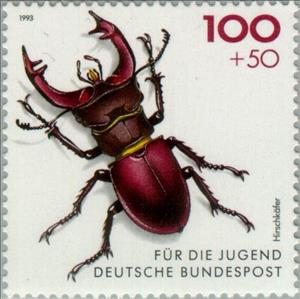Stamp: Stag Beetle (Lucanus cervus) (Germany, Federal Republic 1993)
Stag Beetle (Lucanus cervus) (Germany, Federal Republic 1993)
15 April (Germany, Federal Republic ) within release Bugs goes into circulation Stamp Stag Beetle (Lucanus cervus) face value 100+50 German pfennig
| Stamp Stag Beetle (Lucanus cervus) in catalogues | |
|---|---|
| Michel: | Mi:DE 1668 |
| Yvert et Tellier: | Yt:DE 1499 |
Stamp is square format.
Also in the issue Bugs:
- Stamp - Rosalia Longicorn (Rosalia alpina) face value 80+40;
- Stamp - Green Rose Chafer (Cetonia aurata) face value 80+40;
- Stamp - Stag Beetle (Lucanus cervus) face value 100+50;
- Stamp - Green Tiger Beetle (Cicindela campestris) face value 100+50;
- Stamp - Common Cockchafer (Melolontha melolontha) face value 200+50;
Stamp Stag Beetle (Lucanus cervus) it reflects the thematic directions:
Insects (from Latin insectum, a calque of Greek ἔντομον [éntomon], "cut into sections") are a class (Insecta) of hexapod invertebrates within the arthropod phylum that have a chitinous exoskeleton, a three-part body (head, thorax and abdomen), three pairs of jointed legs, compound eyes and one pair of antennae. They are the most diverse group of animals on the planet, including more than a million described species and representing more than half of all known living organisms. The number of extant species is estimated at between six and ten million, and potentially represent over 90% of the differing animal life forms on Earth. Insects may be found in nearly all environments, although only a small number of species reside in the oceans, a habitat dominated by another arthropod group, crustaceans. The life cycles of insects vary but most hatch from eggs. Insect growth is constrained by the inelastic exoskeleton and development involves a series of molts. The immature stages can differ from the adults in structure, habit and habitat, and can include a passive pupal stage in those groups that undergo 4-stage metamorphosis (see holometabolism). Insects that undergo 3-stage metamorphosis lack a pupal stage and adults develop through a series of nymphal stages. The higher level relationship of the Hexapoda is unclear. Fossilized insects of enormous size have been found from the Paleozoic Era, including giant dragonflies with wingspans of 55 to 70 cm (22–28 in). The most diverse insect groups appear to have coevolved with flowerin plants.
Biologically, a child (plural: children) is a human being between the stages of birth and puberty. The legal definition of child generally refers to a minor, otherwise known as a person younger than the age of majority. Child may also describe a relationship with a parent (such as sons and daughters of any age) or, metaphorically, an authority figure, or signify group membership in a clan, tribe, or religion; it can also signify being strongly affected by a specific time, place, or circumstance, as in "a child of nature" or "a child of the Sixties". There are many social issues that affect children, such as childhood education, bullying, child poverty, dysfunctional families, child labor, hunger, and child homelessness. Children can be raised by parents, by fosterers, guardians or partially raised in a day care center.
Animals are multicellular, eukaryotic organisms of the kingdom Animalia (also called Metazoa). All animals are motile, meaning they can move spontaneously and independently, at some point in their lives. Their body plan eventually becomes fixed as they develop, although some undergo a process of metamorphosis later on in their lives. All animals are heterotrophs: they must ingest other organisms or their products for sustenance.



